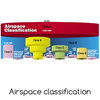I'm a student pilot as well and would definitely recommend talking with your CFI just to continue to have a common understanding of where things are at, what areas need focus, and where you're going etc. All that said, the simple answer to your question is - since the word "through" was included, that would indicate you're inside the Charlie or Bravo airspace (or about to be... you're going "through" it). Lateral just means sideways (side to side, horizontal) and vertical just means up and down. So basically you are flying inside of the rings of the pictures
@champ driver posted above. If you were "underneath" a shelf (ring), you wouldn't be "through" the C or B airspace, you would be outside the B or C airspace.
Hope that helps. Safe flying!



